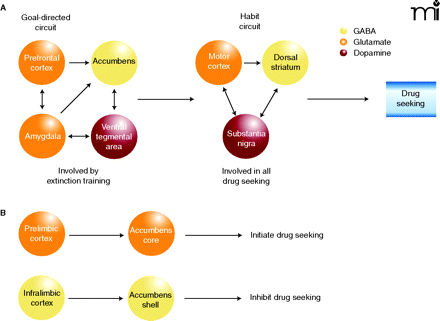
- Institution: Stanford Univ Med Ctr Lane Med Lib/Periodical Dept/Rm L109
- Sign In as Member / Individual
Animal Models and Brain Circuits in Drug Addiction

Brain Circuitry in the Re-instatement of Drug Seeking. A. Goal-directed and habit circuitries represent two levels of regulation of drug seeking. Lever pressing for drug becomes habitual during training, and if animals do not undergo extinction training, and are placed into the training environment after "abstinence" (see legend to Figure 1), behavior is regulated only by the classic corticostriatal habit circuitry. Extinction training, however, engages the second level of regulation—the cortico-amygdala-accumbens circuit, which modulates the habit circuitry via connections through the thalamus (not shown). [For reference, see (4, 42, 43).] B. Simplified rendering of the PFC-to-accumbens circuit that becomes involved by extinction training. The dorsal circuit from the prelimbic cortex to the accumbens core is necessary to initiate drug seeking in response to a cue, stress, or drug-priming injection in extinguished animals, whereas the ventral circuit from the infralimbic cortex to the accumbens shell appears to tonically inhibit drug seeking.


